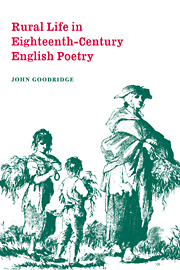Book contents
- Frontmatter
- Contents
- Preface
- Abbreviations, conventions, textual note
- Introduction
- Part I ‘Hard labour we most chearfully pursue’: three poets on rural work
- Part II ‘A pastoral convention and a ruminative mind’: agricultural prescription in The Fleece, I
- 6 Sheep and poetry
- 7 ‘Soil and clime’
- 8 Environment and heredity
- 9 The care of sheep
- 10 The shepherd's harvest
- Appendix A ‘Siluria’
- Appendix B Eighteenth-century sheep breeds
- Notes
- Select bibliography
- Index
- CAMBRIDGE STUDIES IN EIGHTEENTH-CENTURY ENGLSH LITERATURE AND THOUGHT
9 - The care of sheep
Published online by Cambridge University Press: 30 October 2009
- Frontmatter
- Contents
- Preface
- Abbreviations, conventions, textual note
- Introduction
- Part I ‘Hard labour we most chearfully pursue’: three poets on rural work
- Part II ‘A pastoral convention and a ruminative mind’: agricultural prescription in The Fleece, I
- 6 Sheep and poetry
- 7 ‘Soil and clime’
- 8 Environment and heredity
- 9 The care of sheep
- 10 The shepherd's harvest
- Appendix A ‘Siluria’
- Appendix B Eighteenth-century sheep breeds
- Notes
- Select bibliography
- Index
- CAMBRIDGE STUDIES IN EIGHTEENTH-CENTURY ENGLSH LITERATURE AND THOUGHT
Summary
The art of preserving health
In starting with terrain, weather and breed, the three major variables of shepherding, Dyer has prepared the shepherd to begin his task. The rest of his advice concentrates more literally on ‘the care of sheep’. The next priority is to rehearse the major diseases of sheep and their possible preventions and remedies, which the poet does next (lines 251–320). William Youatt describes the shepherding and veterinary advice of an earlier agricultural writer, William Ellis (1744), as ‘a singular compound of good sense and quackery’, and he might have extended the remark to characterise mid eighteenth-century veterinary practice in general. On the one hand certain essentials had been understood, such as the ability of various antiseptic, astringent and mordant chemicals to work positively on external parasites and infections. On the other hand, shepherds and veterinarians were unable to understand or treat effectively a number of important parasite and micro-organism borne diseases. Dyer uses the image of ‘whole flocks’ being ‘swept away’ twice, to describe the effect of the ‘coughing pest’ (lines 264–5), and flash-floods in the South Wales valleys (lines 593–600). The readiness with which this imagery of instant and overwhelming disaster comes to him reflects Dyer's awareness of the lack of control which still marked the shepherd's relationship with the environment, and the vulnerability of even the hardy English sheep to disease and inclemency in the climate.
- Type
- Chapter
- Information
- Rural Life in Eighteenth-Century English Poetry , pp. 144 - 166Publisher: Cambridge University PressPrint publication year: 1996

